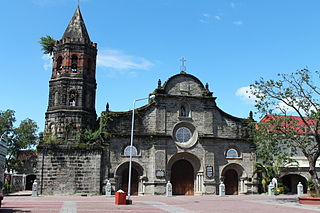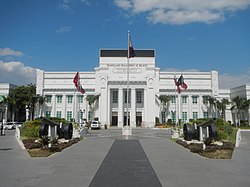
Rizal, officially the Province of Rizal, is a province in the Philippines located in the Calabarzon region in Luzon. Its capital is the city of Antipolo. It is about 16 kilometres (9.9 mi) east of Manila. The province is named after José Rizal, one of the main national heroes of the Philippines. Rizal is bordered by Metro Manila to the west, Bulacan to the north, Quezon to the east and Laguna to the southeast. The province also lies on the northern shores of Laguna de Bay, the largest lake in the country. Rizal is a mountainous province perched on the western slopes of the southern portion of the Sierra Madre mountain range.

Bulacan, officially the Province of Bulacan, is a province in the Philippines located in the Central Luzon region. Its capital is the city of Malolos. Bulacan was established on August 15, 1578, and part of the Metro Luzon Urban Beltway Super Region.

Quezon City, also known as the City of Quezon and Q.C., is the most populous city in the Philippines. According to the 2020 census, it has a population of 2,960,048 people. It was founded on October 12, 1939, and was named for Manuel L. Quezon, the second president of the Philippines. The city was intended to be the national capital of the Philippines that would replace Manila, as the latter was suffering from overcrowding, lack of housing, poor sanitation, and traffic congestion. To create Quezon City, several barrios were carved out from the towns of Caloocan, Marikina, San Juan and Pasig, in addition to the eight vast estates the Philippine government purchased for this purpose. It was officially proclaimed as the national capital on October 12, 1949, and several government departments and institutions moved out of Manila and settled into the new capital city. This necessitated the expansion of the city northwards, carving out Novaliches from Caloocan which divided it into two non-contiguous parts. Several barrios were also taken from San Mateo and parts of Montalban. However, on June 24, 1976, Presidential Decree 940 was enacted, which reverted back to Manila the status of being the national capital while the whole of Metro Manila was designated as the seat of government.

Malabon, officially known as the City of Malabon, is a 1st class highly urbanized city in the National Capital Region of the Philippines. According to the 2020 census, it has a population of 380,522 people.

Malolos, officially known as the City of Malolos, is a 3rd class component city and capital of the province of Bulacan, Philippines. According to the 2020 census, it has a population of 261,189 people.

Deodato Arellano y de la Cruz was a Filipino propagandist and the first president of the Katipunan, which was founded at his home in Azcarraga Street, Manila. He was first to be given the title Supremo by the Katipunan. After studying bookkeeping in Ateneo de Municipal de Manila, he became an assistant clerk for the Spanish military. He was a member of the Freemasonry in the Philippines and became involved in the Propaganda Movement.

Juan Marcos Arellano y de Guzmán, or Juan M. Arellano, was a Filipino architect, best known for Manila's Metropolitan Theater (1935), Legislative Building, the Manila Central Post Office Building (1926), the Rizal Memorial Sports Complex (1934), the Central Student Church, the old Jaro Municipal Hall (1934) and the Old Iloilo City Hall (1935) in Iloilo, the Negros Occidental Provincial Capitol (1936), the Cebu Provincial Capitol (1937), the Bank of the Philippine Islands Cebu Main Branch (1940), Misamis Occidental Provincial Capitol Building (1935), Cotabato Municipal Hall (1940) and the Jones Bridge during the pre-war era.

The Rizal Memorial Coliseum is an indoor arena in the Rizal Memorial Sports Complex in Manila, Philippines. Its capacity is 6,100.

The Manila North Cemetery is one of the oldest cemeteries in Metro Manila, Philippines. The cemetery is owned by and located in the City of Manila, the national capital, and is one of the largest in the metropolis at 54 hectares. It is located alongside Andrés Bonifacio Avenue and borders two other important cemeteries: the La Loma Cemetery and the Manila Chinese Cemetery. Numerous impoverished families notably inhabit some of the mausoleums.

The Metropolitan Theater, abbreviated as MET, is a Philippine Art Deco building found near the Mehan Garden located on Padre Burgos Avenue corner Arroceros Street, near the Manila Central Post Office. It was designed by architect Juan M. Arellano and inaugurated on December 10, 1931.
Juan Felipe de Jesús Nakpil, KGCR known as Juan Nakpil, was a Filipino architect, teacher and a community leader. In 1973, he was named one of the National Artists for architecture. He was regarded as the Dean of Filipino Architects.

The Manila City Hall is the official seat of government of the City of Manila, located in the historic center of Ermita, Manila. It is where the Mayor of Manila holds office and the chambers of the Manila City Council is located. It was originally intended to be a part of a national government center envisioned by Daniel Burnham in the 1900s. Although the dream plan was not fully implemented, some buildings for the proposed government center were constructed, including the Old Legislative Building, and the Agriculture and Finance Buildings.

The Cebu Provincial Capitol is the seat of the provincial government of Cebu in the Philippines. Located at the north end of Osmeña Boulevard in Cebu City, it was designed by Juan M. Arellano, a Filipino architect best known for the Manila Metropolitan Theater (1935), the Legislative Building, and the Manila Central Post Office (1926). An inscription on the central concave portion of its façade reads, "The authority of the government emanates from the people. Erected A.D. MCMXXXVII."

Saint John the Baptist Parish is a 19th-century Roman Catholic church in San Juan, Metro Manila, Philippines. It belongs to the Roman Catholic Archdiocese of Manila.

The Negros Occidental Provincial Capitol is the seat of the provincial government of Negros Occidental located at Gatuslao St., Bacolod, Philippines. Within its complex is the Capitol Park and Lagoon.

Rizal Memorial Library and Museum is a three-story, pre-war, neoclassical heritage site and landmark in Cebu City, Philippines. Dedicated to the national hero, Jose P. Rizal, it was designed by Filipino architect Juan M. Arellano, who also designed the Cebu Provincial Capitol building. Inaugurated in 1939, the building survived World War II. It is located along Osmeña Boulevard and houses the offices of Cebu City Tourism, the Cultural and Historical Affairs Commission, the Sinulog Hall on the third floor, the Cebu City Museum of Visual Arts on the second floor, and the Cebu City Public Library on the ground floor.
Pedro Siochi was a notable Philippine architect and civil engineer of famous landmarks in the Philippines.

















